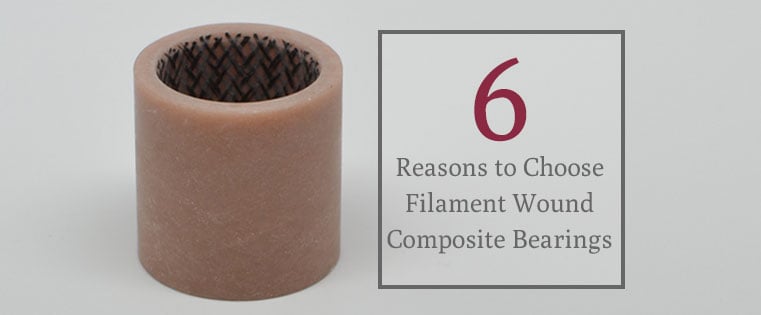
Looking for a tough, durable and versatile bearing for an industrial application? A filament wound composite bearing might be just the ticket based on several key qualities. Let’s review the top reasons:
What is a filament?
A filament is defined as a conducting thread or wire that has a high melting point. Filaments are usually associated with an electric or vacuum tube, which is then heated to produce an electric current inside a bulb.
In the world of composite bearings, multiple filament threads are wound in a helix configuration to improve the strength of a bearing wall. In the case of our CJ (composite journal) bearing, the liners are made of PTFE/Nomex/Polyester which are woven into a sock and then intertwined with glass filaments to produce a reinforced product. This multilayer design gives the bearing reinforcement for good reliability, and longer service uptime without the need for maintenance. The bearings are wound on precision mandrels with preset ID dimensions.
What are the benefits of a filament wound bearing?
Filament wound bearings are among the strongest in their class and offer superior versatility:
- Element of elasticity - Filament wound bearings present a good level of elasticity that falls between rigid metals and soft plastics. This modulus gives the bearing surface the ability to support heavy loads, but enough flexibility to tolerate shaft misalignment without stressing the bearings ends.
- Shock absorption - A composite filament wall acts like a spring to absorb shock and vibration in high-stress environments. Even our thin wall CJ’s have the ability to compress and recover during shock and impact conditions without failure.
- Resistance to corrosion - The special winding technique and multilayer construction gives filament bearings good resistance to chemical, galvanic (electrochemical contact) and fretting corrosion. These are all primary causes of bearing failure. Explore more causes of bearing failure.
- Versatile motions - Filament wound CJ’s and FCJ’s are best applied in oscillating motions at variable frequencies but can also be utilized in lubrication free rotary and lineal motions.
- Good service lifetime - A filament wound composite is best used against a hard shaft and 8-16 rms finish to resist abrasion and fretting and improve overall service. In fact, one test showed that improving the surface of 50-55 Rc hardness and an 8 rms finish could extend the wear life of a bearing from 500,000 cycles to over 1 million cycles. All without lubrication.
- Self-lubricating qualities - Composite bearings run dry and grease-free to help you save on all costs associated with manual grease application.
You’ll find filament wound composites work exceptionally well as a bronze replacement in applications including transportation, construction, mining and more. For best results, we also recommend that you look for bearings that are designed and manufactured in the US. Ask us for details.
For a general primer in the different types of bearings, how they fail, and bearing selection strategies, check out our Bearings 101 feature article.









